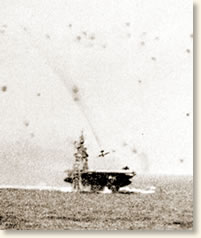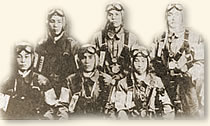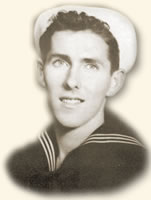|
Kamikaze Attack, 1944
In the middle of the 13th century, Mongol fleets sailed to attack a helpless Japan. As the invaders approached the Japanese coast, terrific winds arose, smashed the Mongol ships and thwarted the attack. This "Divine Wind" - what the Japanese referred to as the "kamikaze" - saved Japan.

Kamikaze Attack
|
Seven hundred years later, as the American war machine moved slowly but inexorably across the Pacific towards their home islands, the Japanese again called upon the kamikaze for salvation. This time the "Divine Wind" took the form of suicidal pilots who sacrificed their lives in order to assure that their explosive-laden planes hit their targets. It became the Japanese weapon that the American Navy feared most.
The Kamikazes made their first appearance during the Battle of Leyte Gulf in
October 1944. By 1945, they were a terrifying threat, "the only weapon I feared
in war," declared Admiral Halsey. Their most devastating attacks occurred during
the battle for Okinawa where the suicide pilots inflicted the heaviest losses
the US Navy ever suffered in a single battle.
The last suicide attack occurred after the Japanese surrender when the commander of the kamikaze forces led a flight of eleven planes on an attack against US ships at Okinawa.
James J. Fahey joined the Navy in October 1942. He became a Seaman First Class aboard the cruiser USS Montpelier and saw action from the Solomon Islands through the end of the war. On November 27, 1944 the Montpelier was in the Leyte Gulf in support of the American invasion that would eventually liberate the Philippines. The task force that the Montpelier was a part of consisted of 18 ships and this morning they were refueling - the most vulnerable time for an enemy attack.
To protect themselves, the ships formed a defensive circle around the fuel-laden tanker while each took its turn at refueling. If the enemy arrived, sailors armed with axes aboard the refueling warship would cut the fuel lines to allow the ship to get into battle position and as far away from the tanker as possible.
James Fahey kept a diary of his experiences. We join his story as the Montpelier's alarms announce a Japanese attack:
"At 10:50 A.M. this morning General Quarters sounded, all hands went to their battle stations. At the same time a battleship and a destroyer were alongside the tanker getting fuel. Out of the clouds I saw a big Jap bomber come crashing down into the water. It was not smoking and looked in good condition. It felt like I was in it as it hit the water not too far from the tanker, and the 2 ships that were refueling. One of our P-38 fighters hit it. He must have got the pilot. At first I thought it was one of our bombers that had engine trouble.
It was not long after that when a force of about 30 Jap planes attacked us. Dive bombers and torpedo planes. Our two ships were busy getting away from the tanker because one bomb-hit on the tanker and it would be all over for the 3 ships.
The 2 ships finally got away from the tanker and joined the circle. I think the destroyers were on the outside of the circle. It looked funny to see the tanker all by itself in the center of the ships as we circled it, with our guns blazing away as the planes tried to break through. It was quite a sight, better than the movies. I never saw it done before. It must be the first time it was ever done in any war.

Kamikaze Pilots sit for a
portrait before their last flight
|
Jap planes were coming at us from all directions. Before the attack started we did not know that they were suicide planes, with no intention of returning to their base. They had one thing in mind and that was to crash into our ships, bombs and all. You have to blow them up, to damage them doesn't mean much.
Right off the bat a Jap plane made a suicide dive at the cruiser St. Louis there was a big explosion and flames were seen shortly from the stern. Another one tried to do the same thing but he was shot down. A Jap plane came in on a battleship with its guns blazing away. Other Jap planes came in strafing one ship, dropping their bombs on another and crashing into another ship. The Jap planes were falling all around us, the air was full of Jap machine gun bullets. Jap planes and bombs were hitting all around us. Some of our ships were being hit by suicide planes, bombs and machine gun fire. It was a fight to the finish.
While all this was taking place our ship had its hands full with Jap planes. We knocked our share of planes down but we also got hit by 3 suicide planes, but lucky for us they dropped their bombs before they crashed into us. In the meantime exploding planes overhead were showering us with their parts. It looked like it was raining plane parts. They were falling all over the ship. Quite a few of the men were hit by big pieces of Jap planes.
We were supposed to have air coverage but all we had was 4 P-38 fighters, and when we opened up on the Jap planes they got out of the range of our exploding shells. They must have had a ring side seat of the show. The men on my mount were also showered with parts of Jap planes. One suicide dive bomber was heading right for us while we were firing at other attacking planes and if the 40 mm. mount behind us on the port side did not blow the Jap wing off it would have killed all of us. When the wing was blown off it, the plane turned some and bounced off into the water and the bombs blew part of the plane onto our ship.

James J. Fahey, 1943
|
...A Jap dive bomber crashed into one of the 40 mm. mounts but lucky for them it dropped its bombs on another ship before crashing. Parts of the plane flew everywhere when it crashed into the mount. Part of the motor hit Tomlinson, he had chunks of it all over him, his stomach, back, legs etc.The rest of the crew were wounded, most of them were sprayed with gasoline from the plane. Tomlinson was thrown a great distance and at first they thought he was knocked over the side. They finally found him in a corner in bad shape.
...Planes were falling all around us, bombs were coming too close for comfort. The Jap planes were cutting up the water with machine gun fire. All the guns on the ships were blazing away, talk about action, never a dull moment. The fellows were passing ammunition like lightning as the guns were turning in all directions spitting out hot steel...The deck near my mount was covered with blood, guts, brains, tongues, scalps, hearts, arms etc. from the Jap pilots. The Jap bodies were blown into all sorts of pieces. I cannot think of everything that happened because too many things were happening at the same time."
References:
James Fahey's account appears in: Fahey, James, Pacific War
Diary 1942-1945 (1963); Inoguichi, R, Nakajma T., and Pineau, R. The Divine Wind:
Japan's Kamikaze Force in World War II (1959).
How To Cite This Article:
"Kamikaze Attack, 1944," EyeWitness to History, www.eyewitnesstohistory.com (2005).
|






